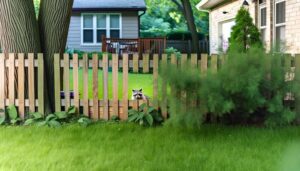How to Use Mothballs to Keep Raccoons Away
Mothballs are sometimes used to deter raccoons due to their pungent odor, but they pose significant safety risks. Composed of naphthalene or paradichlorobenzene, mothballs release toxic vapors that can harm pets, children, and wildlife.
They are not always effective against raccoons, which are intelligent and adaptable creatures. For safer and more reliable raccoon control, consider alternatives such as ammonia-soaked rags, cayenne pepper, or professional wildlife management services.
Using mothballs improperly could result in legal consequences and health hazards. Learn about safer and more effective strategies to keep raccoons at bay.

Key Takeaways
- Mothballs can deter raccoons due to their strong, pungent odor.
- The toxic nature of mothballs requires careful handling and strategic placement.
- Safety guidelines must be followed to avoid harmful exposure to humans and pets.
- Mothballs should be part of a broader wildlife management strategy for effective raccoon control.
- Alternative natural repellents like ammonia or peppermint oil can also be effective and safer.
Understanding Raccoon Behavior
To effectively deter raccoons using mothballs, it is crucial to first grasp their nocturnal behavior and attraction to human habitats. Raccoons are primarily active during the night, scavenging for food and shelter. Their omnivorous diet means they are drawn to garbage, pet food, and gardens.
Urban environments provide ample opportunities for raccoons to thrive, often leading them into residential areas. Understanding these behavioral patterns enables more strategic placement of deterrents. Focus on securing garbage bins, eliminating food sources, and sealing entry points to structures.
Mothballs, when used correctly, can complement these efforts by creating an unpleasant environment for raccoons. However, safety precautions must be taken to ensure the well-being of humans and pets when deploying mothballs as a deterrent.
What Are Mothballs?
Mothballs are small, chemical-based products primarily made from either naphthalene or paradichlorobenzene, substances known for their pungent odor and insect-repelling properties.
Commonly used in households to protect clothing and other materials from moth damage, these chemicals can also have applications in deterring pests such as raccoons.
However, due to their toxic nature, careful handling and adherence to safety guidelines are imperative to prevent harm to humans, pets, and the environment.
Chemical Composition Explained
Comprised primarily of either naphthalene or paradichlorobenzene, mothballs are solid pesticide formulations designed to deter and eliminate fabric pests like moths and larvae. These chemicals sublimate, shifting directly from solid to gas, releasing toxic vapors that are effective in confined spaces.
To guarantee safe usage, consider the following:
- Ventilation: Use in well-aired areas to minimize inhalation risks.
- Storage: Keep mothballs in sealed containers to control vapor release.
- Placement: Place mothballs only in enclosed spaces like storage bins or garment bags.
- Disposal: Dispose of used mothballs according to local hazardous waste guidelines.
Understanding the chemical nature of mothballs is essential for their safe and effective application, ensuring protection without compromising health.
Common Household Uses
Many households utilize mothballs not only to protect clothing from insect damage but also to deter pests such as raccoons, mice, and snakes from invading indoor and outdoor spaces. Comprised primarily of naphthalene or paradichlorobenzene, mothballs release a strong, pungent odor that is effective in repelling these unwanted visitors.
When using mothballs outside their traditional use, it is vital to follow safety guidelines to prevent accidental exposure to humans and pets. Always place mothballs in well-ventilated areas and contained spaces to minimize health risks. Additionally, consult product labels for specific usage instructions.
How Mothballs Work
Naphthalene and paradichlorobenzene, the primary chemicals in mothballs, sublimate into a gas that can deter raccoons through its pungent odor. These substances convert directly from a solid to a gas at room temperature, releasing fumes that are unpleasant to many pests, including raccoons.
For best use and safety, consider the following:
- Ventilation: Guarantee the area is well-ventilated to prevent the buildup of toxic fumes.
- Containment: Place mothballs in sealed containers with small openings to control the release of the gas.
- Placement: Position mothballs in inaccessible locations, away from children and pets.
- Monitoring: Regularly check the area to ensure effectiveness and safety.
Understanding these principles is crucial for efficient and safe use of mothballs.
Mothballs and Raccoons
Effectively utilizing mothballs to deter raccoons requires a strategic approach that balances effectiveness with safety considerations.
Mothballs, composed of naphthalene or paradichlorobenzene, emit strong odors that can repel raccoons. However, their toxic nature necessitates careful handling and application.
Place mothballs in areas where raccoons frequent, such as attics or crawl spaces, but make sure they are inaccessible to children and pets. Use protective gloves and avoid inhalation during placement.
Additionally, it's important to recognize that mothballs are not a foolproof solution and should be part of a broader wildlife management strategy. Combining mothball use with other deterrents like secure trash bins and exclusion techniques can enhance effectiveness while minimizing risks to household members and the environment.
Scientific Evidence
Scientific studies have yielded mixed results regarding the efficacy of mothballs in repelling raccoons, underscoring the necessity for a thorough and multi-faceted approach to wildlife management. While some research indicates a temporary deterrent effect, others suggest limited long-term benefits.
Experts recommend considering the following points:
- Concentration: Higher levels may show temporary effectiveness but increase safety concerns.
- Environment: Outdoor conditions can dilute the efficiency of mothballs.
- Behavioral Adaptation: Raccoons may adjust to the presence of mothballs over time.
- Alternative Methods: Combining mothballs with other deterrents can enhance overall efficiency.
Utilizing a combination of methods guarantees a safer and more humane approach to managing raccoon populations, reflecting a commitment to responsible wildlife management practices.
Health Risks of Mothballs
The use of mothballs as a deterrent for raccoons poses significant health risks to humans, pets, and other wildlife due to their toxic chemical components. Mothballs typically contain either naphthalene or paradichlorobenzene, both of which can cause serious harm if inhaled or ingested. Exposure to these chemicals can lead to symptoms such as dizziness, headaches, nausea, and respiratory distress. Pets and children are particularly vulnerable, as they may accidentally ingest or come into close contact with mothballs.
Additionally, the chemicals can leach into soil and water, impacting local ecosystems. Given these risks, using mothballs in open areas or in ways not intended by the manufacturer is strongly discouraged. Consider safer, non-toxic alternatives for pest control to protect health and the environment.
Legal Considerations
Understanding the legal considerations surrounding the use of mothballs for raccoon deterrence is important to guarantee compliance with local regulations and to avoid potential fines or legal repercussions. Mothballs are classified as pesticides, and their use is governed by strict regulations.
To secure lawful application, consider the following:
- Label Instructions: Always adhere to the instructions provided on the mothball packaging, which are legally binding.
- Local Regulations: Verify local laws regarding pesticide use; some jurisdictions may prohibit or restrict mothball usage outdoors.
- Environmental Impact: Evaluate the potential effects on non-target wildlife and ecosystems, as improper use can lead to environmental harm.
- Health and Safety: Understand the health risks posed to humans and pets, ensuring that mothballs are used in a safe and controlled manner.
Alternative Deterrents
Exploring alternative deterrents for raccoons provides safer and often more effective solutions while minimizing environmental and health risks. Motion-activated sprinklers can startle and repel raccoons without causing harm, making them a humane option.
Installing bright lights or using ultrasonic devices can disrupt raccoons' nocturnal activities, encouraging them to relocate. Securing garbage bins with tight-fitting lids and removing outdoor food sources are practical steps to deter raccoons.
Additionally, using natural repellents like predator urine can create an inhospitable environment for these animals. Ensuring that potential entry points to homes and attics are sealed can also prevent raccoon intrusions. These methods prioritize safety and effectiveness, ensuring a responsible approach to raccoon control.
DIY Raccoon Repellents
When considering DIY raccoon repellents, natural options such as peppermint oil or ammonia-soaked rags can be both effective and environmentally friendly.
Homemade spray recipes often include ingredients like hot peppers or garlic, which are known to deter raccoons due to their strong scents.
Ensuring these techniques are applied safely and consistently is essential for achieving the desired results without causing harm to pets or local wildlife.
Natural Repellent Options
For those seeking natural repellent options to deter raccoons, several DIY solutions can be both effective and safe when used correctly. Consider the following natural deterrents:
- Ammonia-soaked rags: Place rags soaked in ammonia around suspected entry points to create an unpleasant odor.
- Cayenne pepper: Sprinkle cayenne pepper in areas frequented by raccoons, as the strong scent can be a deterrent.
- Garlic and pepper mixture: Crush garlic and mix with water and pepper; apply this mixture around your yard to create an irritating barrier for raccoons.
- Motion-activated lights: Install lights that activate with movement to startle and discourage raccoons from entering your property.
These methods offer practical, humane ways to protect your space while ensuring the safety of both humans and animals.
Homemade Spray Recipes
Crafting homemade spray repellents can serve as an important and eco-friendly method to deter raccoons from invading your property. One popular recipe involves mixing water with strong, spicy ingredients like hot sauce or crushed red pepper flakes.
Another effective blend uses a combination of garlic, onion, and water, which raccoons find repugnant. When preparing these solutions, it is vital to wear protective gloves and eyewear to prevent irritation.
Ensure thorough blending and decant the solution into a spray bottle for easy application. Apply generously around entry points and areas frequented by raccoons. For best results, reapply after rain or heavy dew.
These homemade repellents offer a safe alternative to chemical solutions, aligning with eco-conscious practices while effectively deterring raccoons.
Effective Deterrent Techniques
Beyond homemade sprays, several other effective DIY techniques can be employed to deter raccoons from your property. Here are four practical methods:
- Ammonia Soaked Rags: Place rags drenched in ammonia around entry points to create an unpleasant odor barrier.
- Motion-Activated Sprinklers: These devices startle raccoons with a burst of water, encouraging them to leave.
- Ultrasonic Repellents: Emit high-frequency sounds that are disturbing to raccoons but inaudible to humans.
- Secure Trash Cans: Use bungee cords or weights to ensure lids remain tightly closed, removing a primary food source.
Implementing these techniques requires minimal investment and can significantly enhance the safety and cleanliness of your property, ensuring a raccoon-free environment.
Professional Solutions
Engaging the services of wildlife control professionals can provide a safe and effective solution for managing raccoon infestations. These experts employ humane and efficient techniques, such as live trapping and exclusion methods, ensuring minimal harm to the animals and the environment.
Additionally, professionals can assess potential entry points and implement structural modifications to prevent future invasions. They are well-versed in local wildlife regulations, ensuring compliance while addressing the issue.
Safety is paramount; professionals use personal protective equipment to handle raccoons, reducing the risk of diseases such as rabies. By opting for professional assistance, property owners not only resolve immediate problems but also gain long-term peace of mind, knowing that their homes are protected against future wildlife intrusions.
Conclusion
The effectiveness of mothballs as a raccoon deterrent presents a complex issue. While mothballs possess certain properties that might repel raccoons, scientific evidence remains inconclusive, and legal restrictions further complicate their use.
Given the potential health hazards associated with mothballs, both to humans and wildlife, alternative methods and professional solutions should be prioritized. The suspense lies in whether a safe, effective, and legally compliant solution to raccoon intrusion will ultimately emerge.
The search for a definitive answer continues.






